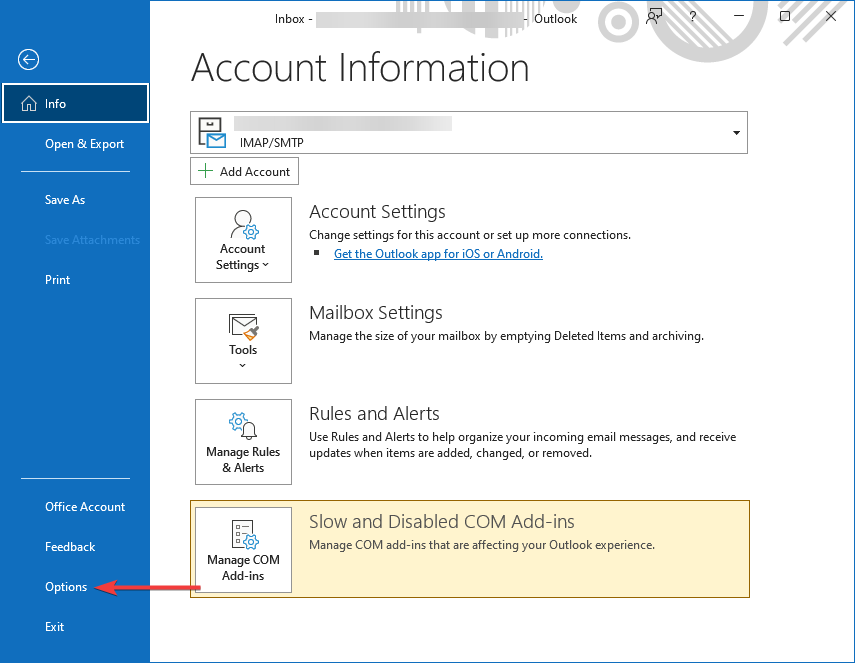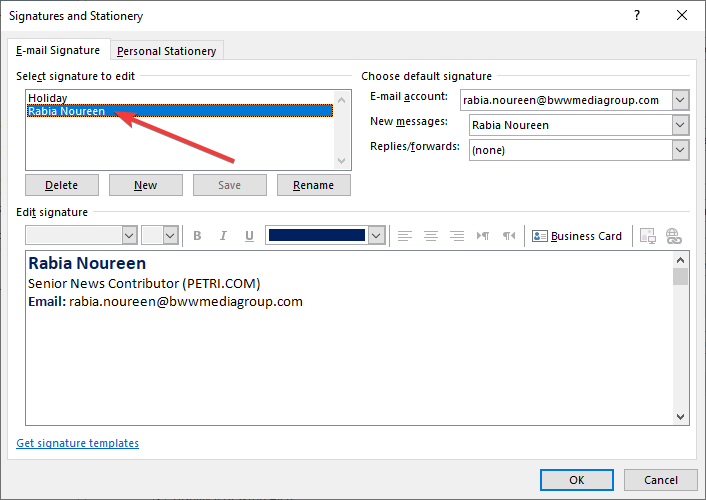How to Change an Email Signature in Outlook

In this guide, I’ll explain how to change an email signature in Outlook for Windows and other platforms. For business users, a professional email signature is an important tool to build brand awareness, generate leads and create direct contact with clients and partners. It can also help to drive traffic to your website and social media accounts.
An email signature is a customized block of text that appears at the bottom of messages as a footer. It often includes the sender’s name, company name, job title, website URL, and professional contact information (such as telephone numbers, email addresses, and social media accounts). Outlook can save all this information for you so you don’t have to enter it in every email.
How to change an email signature in Outlook
Here’s how to quickly change your email signature in Outlook.
- In the Outlook desktop app, click File > Options > Mail > Signatures.
- Select the signature to edit and change it in the Edit signature box.
- To complete the process, select Save > OK.
For more detailed instructions regarding the different versions of Outlook, keep reading below.
Why should you change your email signature?
An email signature allows recipients to verify the sender’s identity, which is why it’s important to ensure that the information is up-to-date. An Outlook user may want to update their email signature’s contents in various situations, such as changing a phone number or job title.
Despite the rise of social media and communication platforms such as Slack or Microsoft Teams, email is a technology that’s here to stay. A lot of business relationships still happen through emails, and email marketing is still very much a thing as well.
Unlike the aforementioned platforms, email is built on open standards, which is why we have various webmail solutions and desktop clients such as Outlook. Microsoft’s email client remain really popular in the business world, but as we’ll see in this post, the process to change your signature isn’t exactly the same across all platforms.
How to change an email signature in Outlook for Windows
Users can change the contents of their email signatures in Outlook for Windows by following the steps mentioned below:
- Launch the app and click on the File tab.

- Navigate to the sidebar, click Options, and then select Mail.

- In the right pane, click the Signatures button beside the Create or modify signatures for messages option.

- In the Signatures and Stationery pop-up window, choose the one you want to edit.

- The signature content will automatically appear in the Edit signature box. Make all the changes in the editor box and click Save >> OK.

- Your changes will be saved automatically.
Now, you can create a new email message to send to a recipient. Your new signature will automatically appear at the bottom of the message.
How to change a signature in Outlook for Mac
If you’re using Outlook for Mac, follow these instructions to change your email signature:
- Open the app and go to Outlook >> Preferences.

- In the Email section, click on Signatures and select the one you want to edit.

- Select the Edit button and make all the changes in the Signature editor.

- Click the Save button at the top and close the window once you’re done.
How to change a signature in Outlook on the web
It is also possible to change the contents of an email signature in the web version of Outlook. The process is the same regardless of whether you sign in with a work or school account or a personal Microsoft account.
- Open the app on the web and log into your account.
- Click the Settings icon available in the right-hand corner. Select the View All Outlook Settings option available at the bottom of the sidebar.

- In the Settings window, click Mail in the left navigation pane and select Compose and Reply.

- Click the drop-down menu under New Signature and select the one you want to edit.

- Finally, make the changes in the editor box and click the Save button to save the modified signature.

How to change a signature on the Outlook mobile apps
The process to change your signature on Outlook for iOS and Android is the same. Here’s how to proceed:
- Open the app and then tap the Profile icon in the top left corner of the screen.

- Tap the gear icon to open the Settings menu.

- Scroll down to the Mail section and tap Signature.

- In that window, tap the text field to change your existing signature. Once you’re done, tap the checkmark icon to save it.

Tips for managing email signatures across an organization
For IT admins, keeping email signatures consistent across an organization can be a difficult and time-consuming task. Companies spend thousands of dollars designing their advertising and marketing campaigns, but email signature management is something that’s often overlooked.
For organizations using Microsoft 365, IT administrators can leverage automated solutions to standardize company-wide email signatures. Microsoft has published a step-by-step guide on how to create organization-wide signatures and disclaimers in Microsoft 365.
Third-party Outlook signature management with Set-OutlookSignatures
There is also a free third-party application called “Set-OutlookSignatures” that can help you manage email signatures and Out of Office (OOO) auto-reply messages in Outlook. IT admins can create and deploy signatures and OOO messages centrally without any end-user intervention.
Set-OutlookSignatures provides built-in templates to simplify the design process and supports on-premises, hybrid and cloud-only environments. The app doesn’t require installation on client or server machines, but it does need a file share on a server, PowerShell, and Microsoft Office.
Conclusion
As we’ve seen throughout this article, the process for changing your email signatures across the different versions of Outlook isn’t exactly similar, though it’s still pretty straightforward. Anyway, I hope that this guide will help you make the best use of Outlook on all platforms, and I also invite you to read my previous guide on how to schedule emails in Outlook.



